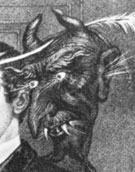The Lincoln Assassination ExhibitThe Lost Museum Archive

At 7 P.M. on April 14, 1865, a young actor staying at the National Hotel in Washington, D.C., approached the desk clerk and asked if he was going to attend that evening’s performance of the popular comedy Our American Cousin at Ford’s Theatre. "There will be some fine acting tonight," John Wilkes Booth said. Two and a half hours later Booth made his appearance at the theater, entered the momentarily unguarded box in which Abraham Lincoln was seated, leveled a six-inch brass derringer at the back of the president’s head, and pulled the trigger. At the same time as Booth fired the shot, his accomplices tried to assassinate Secretary of State William Seward. The attempt on Seward’s life was unsuccessful, but Lincoln died at 7:22 the following morning. After firing the fatal shot, Booth managed to escape but broke his leg as he leapt from the box onto the theater stage. Booth was finally trapped in a Virginia barn on April 26th and killed. His co-conspirators were captured, tried, and either executed or imprisoned. P. T. Barnum, an admirer and supporter of Lincoln, nevertheless exploited the sensation surrounding the assassination--and was widely criticized for keeping the American Museum open when the train bearing the president’s body passed through the city.